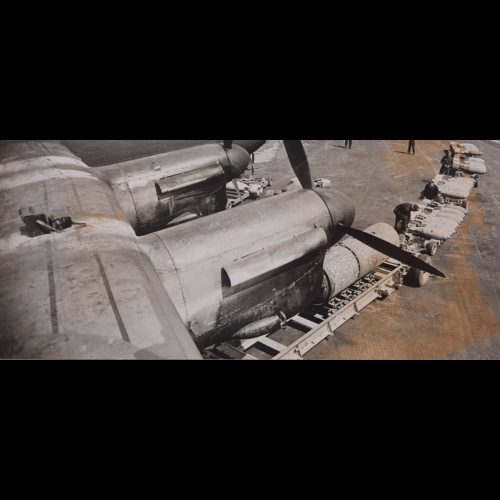-
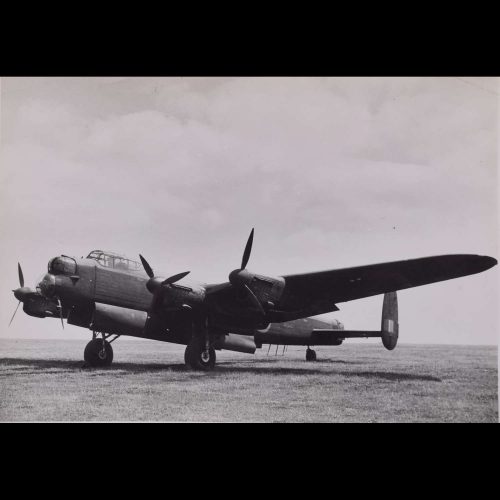
Lancaster HK543
Original Silver Gelatin photograph 19 x 25 cm Stamped to reverse "Copyright 'the Aeroplane'" 23 July 1945 HK543 was a Lancaster III, probably produced in 1943. Here she is shown in July 1945, she was recorded photgraphically on bombing trials from Boscombe Down that month, this photograph may reasonably be assumed to be from that event. Provenance: from the collection of Philip J R Moyes, author of many books on the RAF, most notably The Pictorial History which ran to several volumes. Condition: mostly good. -
Out of stock
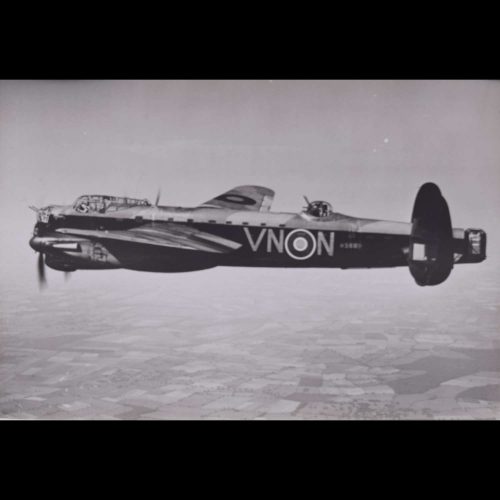
Lancaster Bomber VN-N R5689
Original Silver Gelatin photograph 11 x 16 cm Stamped to reverse 'This TP Copyright illustration from 'The Aeroplane' must not be reproduced without the written permission of Temple Press.' The photograph - and several others of the Swinderby based R5689 of 50 Sqn - was taken on 28 August 1942. The pilot was Sqn Ldr Hugh Everitt. One of the most photographed Lancasters of the RAF's fleet, it was utilised for literature that trained aircrew to recognise the Lancaster. It is also proposed that it be imortalised by the Bomber Gateway Trust with a lifesize replica spraying poppies across the country, just a short distance from its crash site in Lincolnshire. Further funding is required before the project can be completed. R5689 was destroyed on the night of 18/19 September that year. It had been on a sea mining mission and crashed on landing when both port engines failed. Four crew members were killed and three further were injured. Everitt was not flying R5689 on the night it crashed. He survived the war - having flown 56 operations for which he was decorated three times, commanded a V-bomber squadron and played golf into his nineties. He died in 2012 and the Telegraph published an obituary. We have another photograph that includes him sitting on the grass in front of a Lancaster that is being armed. -
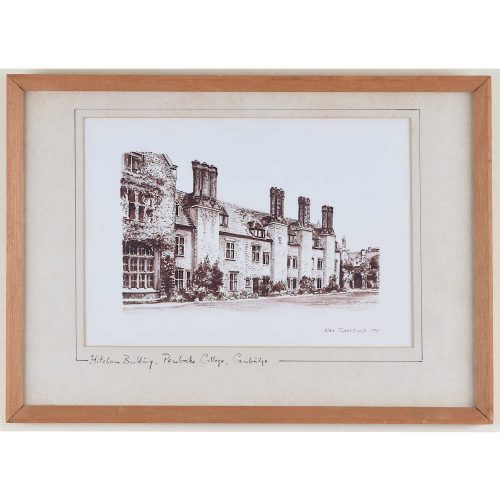
Ray Turrefield (active late 20th century)
Hitcham Building, Pembroke College, Cambridge (1978)
Print 18 x 25 cm Signed and dated lower right. A print of Pembroke College, Cambridge's Hitcham Building. Built in 1659, the Hitcham Building marks the first instance in Pembroke of the Classical Style, which was soon to find full expression in Wren’s Chapel. The building was intended for the Master’s use and was originally connected to the former Master’s Lodge. Both the poet Thomas Gray and the Prime Minister William Pitt lived in the building during their times at Pembroke. Condition: very good. -
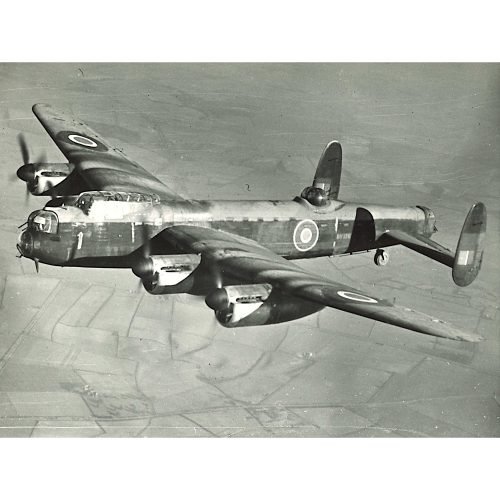
DV170 Lancaster Bomber in flight
Silver Gelatin Photograph 15x20cm Stamped to reverse "Rolls Royce Ltd Hucknall Neg no s76 Copyright Reserved" c. 1940s DV170 was built as a Mk III and converted to Mk VI. Used by Rolls Royce for Merlin trials series 65, 85, 38, 68, 100, 102 & 621 300+ f/hrs testing. Dismantled (probably at Hucknall), by road to Newton 10 December 1947, scrapped by 58 Maintenance Unit. Shown here with 4 Merlin 102s in Avro Tudor power plants with unshrouded exhausts. Provenance: from the collection of Philip J R Moyes, author of many books on the RAF, most notably The Pictorial History which ran to several volumes. -
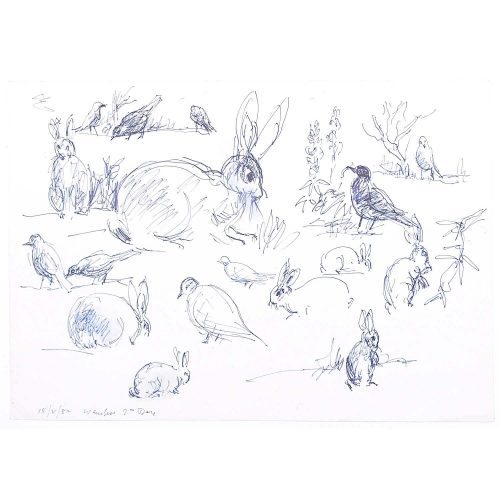
Derrick Latimer Sayer (British: 1917-1992) Rabbits for Beverly Nichols' Cats' ABC
30x21cm Pen and ink Dated 8 vi 1982 Sayer illustrated Beverley Nichols' 'Cats' A.B.C.' and we are delighted to present some of his preparatory drawings here. Search for 'Sayer' in our stock to see more of these utterly charming illustrations - mostly of cats. If you are interested email info@manningfineart.co.uk or call us on 07929 749056. Condition: Good. For biographical details and other works by the artist please click here. -
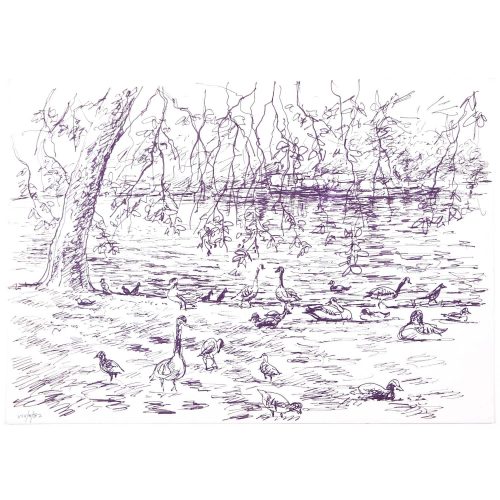
Derrick Latimer Sayer (British: 1917-1992) Ducks for Beverly Nichols' Cats' ABC
30x21cm Pen and ink Dated 8 vi 1982 Sayer illustrated Beverley Nichols' 'Cats' A.B.C.' and we are delighted to present some of his preparatory drawings here. Search for 'Sayer' in our stock to see more of these utterly charming illustrations - mostly of cats. If you are interested email info@manningfineart.co.uk or call us on 07929 749056. Condition: Good. Two punched holes. For biographical details and other works by the artist please click here. -
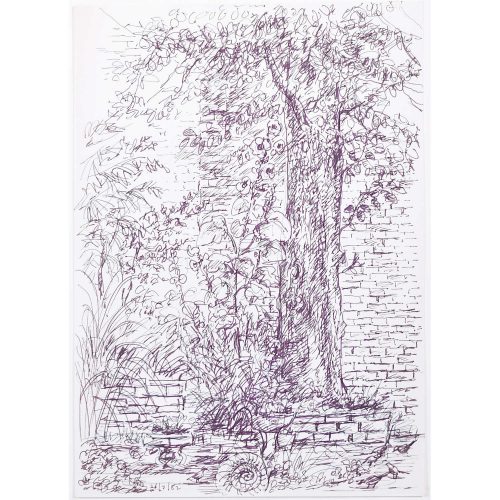
Derrick Latimer Sayer (British: 1917-1992) Tree for Beverly Nichols' Cats' ABC
30x21cm Pen and ink Dated 26 vii 1982 Sayer illustrated Beverley Nichols' 'Cats' A.B.C.' and we are delighted to present some of his preparatory drawings here. Search for 'Sayer' in our stock to see more of these utterly charming illustrations - mostly of cats. If you are interested email info@manningfineart.co.uk or call us on 07929 749056. Condition: Good. For biographical details and other works by the artist please click here. -
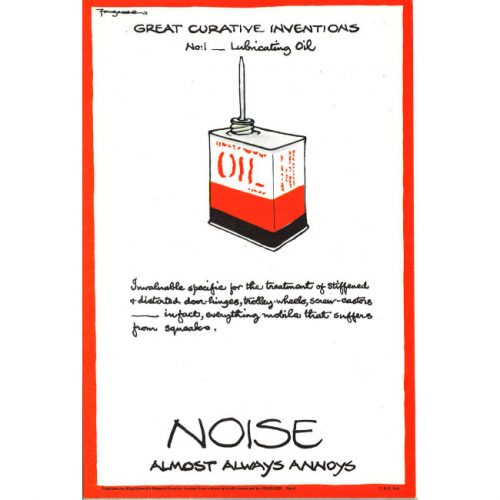
Cyril Kenneth Bird ‘Fougasse’ (British 1887-1965)
Noise Almost Always Annoys
Lithographic poster c1940 29.5 x 19.6 cm (11.5 x 7.5 in) printed by Fosh & Cross Ltd. “Published by King Edward’s Hospital Fund for London from a drawing kindly presented by Fougasse. No. 6. F&C Ltd.” Further biographical details and items by Fougasse are available here. If you are interested email info@manningfineart.co.uk or call us on 07929 749056. -
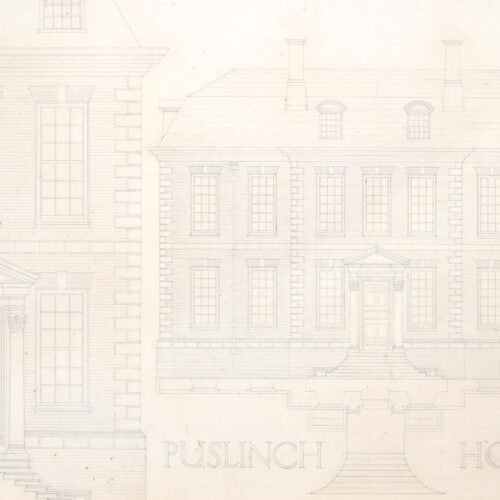
S Clapham (active 1940 - 1960)
Puslinch House
Pencil 55 x 77 cm An architectural drawing of Puslinch House, a fine Christopher Wren-style Georgian mansion in Devon. The estate was owned by the Poslylinch, Mohun, and Upton families before being taken over by the Yonge family in 1718, following the marriage of John Yonge and Mary Upton. The Queen Anne House mansion was built on the occasion of their wedding and an earlier mediaeval house still exists in the grounds as a country cottage. During the war, the house was used as a voluntary hospital for wounded officers. Clapham was an architect based in Stockwell in London. Condition: generally good; a little spotting, backed to board by artist and signed to board lower right. If you are interested, please email info@manningfineart.co.uk or call us on 07929 749056. Click here for other works by the artist. -
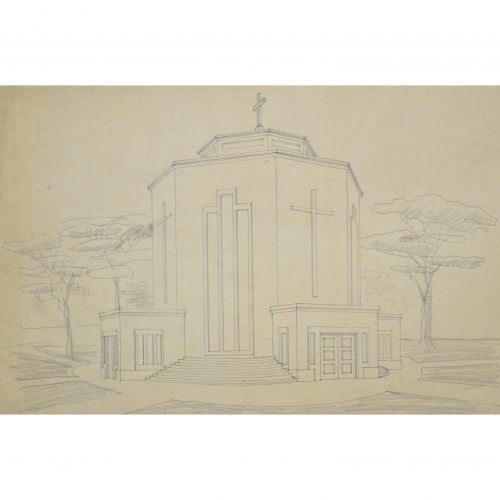
S Clapham (active 1940 - 1960)
A Modernist Church
Pencil 29 x 43 cm A design for an octagonal church in the modernist mid-century style. Clapham was an architect based in Stockwell in London. Condition: generally very good. If you are interested, please email info@manningfineart.co.uk or call us on 07929 749056. Click here for other works by the artist. -
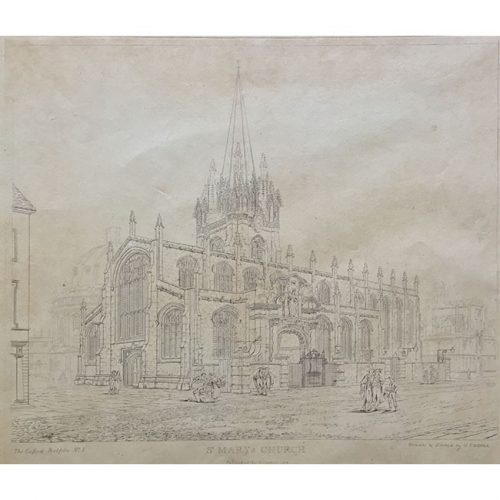
G. Cooper
St. Mary's Church, Oxford
Etching c. 1820 40x47cm From The Oxford Portfolio a series of thirteen views printed on Sepia paper, very rare. If you are interested email info@manningfineart.co.uk or call us on 07929 749056. -
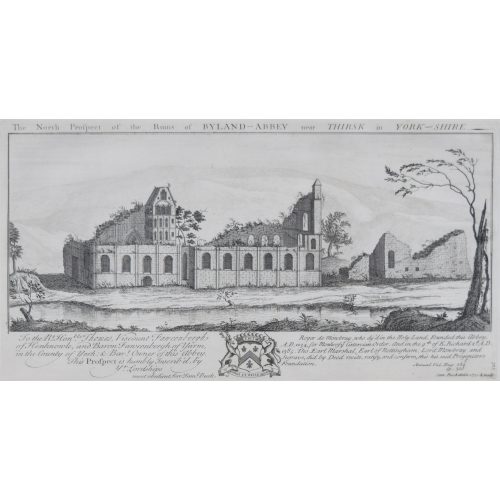
Samuel & Nathaniel Buck
Byland Abbey, Yorkshire
Engraving 37x19cm, c. 1770 "Byland Abbey is an interesting ruin about five miles from Helmsley. It was a fine specimen of ecclesiastical architecture, founded by the monks of Furness, who were driven from their establishment in Lancashire during an incursion of the Scots. When the abbey was dissolved in 1540 its revenues amounted to 238l. 9s. 4d." (Source: The Penny Magazine of the Society for the Diffusion of Useful Knowledge 25 June 1836.) -
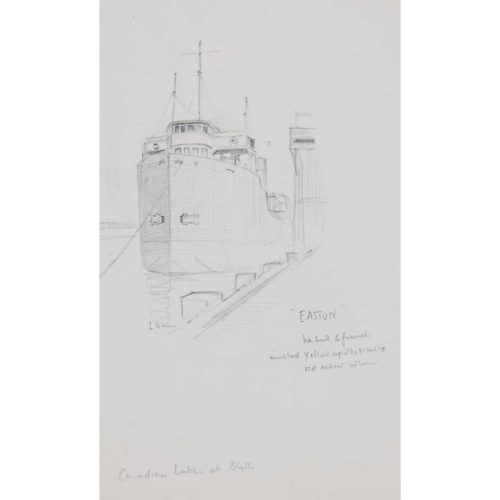
Laurence Dunn (1910-2006)
Drawing of the 'Easton' Canadian laker steamer (c.1950s)
21 x 12.5 cm Pencil Extensively inscribed. Sketch of the ship of the "Easton" in harbour. Dunn has included notes about its colour, presumably for a future painting. Dunn was a well known marine artist and writer. The World Ship Society published the following obituary for Dunn. DUNN, Laurence. [December 15 2006 — Lloyds List] Many readers will be saddened by the death of well-known marine artist and writer Laurence Dunn in his 97th year. A man of encyclopaedic knowledge, he began his lifelong love of ships in Brixham, where he meticulously recorded passing traffic with the exquisitely accurate line drawings which later became something of a trademark. While studying at London’s Central School of Art his work was noticed by the Southern Railway, which commissioned profiles of its fleet, and this in turn led to work for Orient Line, where he also designed the well-known corn-coloured hull, and later Thorneycroft, where he helped with shaping draft plans for a new royal yacht. During the second world was he worked for naval intelligence at the Admiralty, where his technique did much to improve recognition standards, and greatly expanded his shipping clientele, becoming personally known to many chairmen. As well as the shipping press he worked for mainstream publications such as Everybody’s, Sphere and the upmarket comic Eagle. Through his many contacts he enjoyed going to sea in a great variety of ships from aircraft carriers to colliers. Laurence wrote several books, starting with ship recognition titles which introduced new standards of layout, but his best known work was probably Passenger Liners, which was widely taken up by the travel trade. His love of Greece, where he was an early publicist of island cruising, let to involvement in reshaping various passenger liners beginning with Greek Line’s OLYMPIA. In later life he designed several sets of shipping stamps for the Crown Agents, produced photographic volumes on Thames and Mediterranean shipping and still found time to enjoy the passing Thames traffic. Our sympathies go to his wife Jennifer, who provided succour to the many ship lovers who beat a path to the welcoming door of their Gravesend home. -
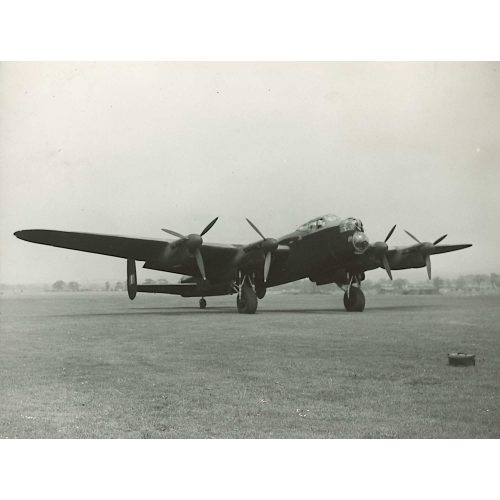
LANCASTER BOMBER AT AN AIRFIELD
Silver Gelatin Photograph for Flight Magazine 15.5x20cm Stamped to reverse "Flight Ref no 18300S Copyright Due Acknowledgment is required if this photograph is reproduced" Almost uniquely, from this series of photographs we have listed, we have been unable to trace another copy of this online. Provenance: from the collection of Philip J R Moyes, author of many books on the RAF, most notably The Pictorial History which ran to several volumes. Inscribed with his initials to reverse, though this has subsequently been concealed with liquid paper. -
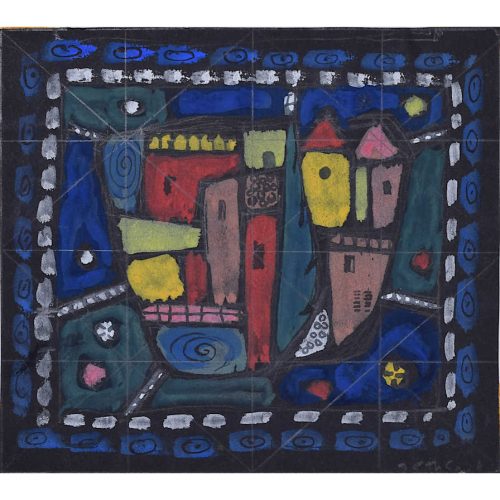
Jane Gray (b.1931)
Mosaic Design
Watercolour 11 x 12.5 cmThis highly modern, colourful and geometric stained mosaic design demonstrates Gray’s wide artistic range and love of employing colour and linear shapes in her work. The central image appears to depict a hamlet-like cluster of abstract houses surrounded by squares of field-like green.
Provenance: the artist’s studio sale. Condition: very good. If you are interested, please email info@manningfineart.co.uk or call us on 07929 749056. For other works by Jane Gray and more information about her, please click here. -
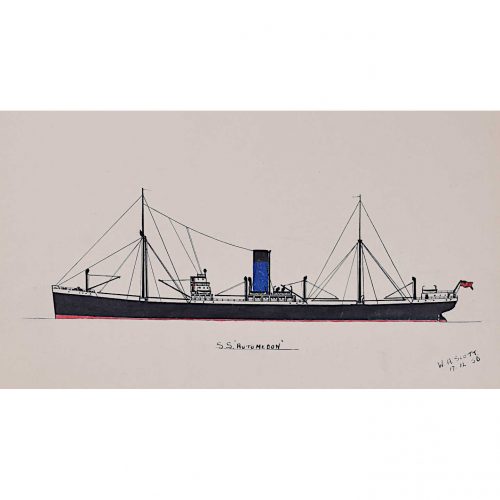
W. A. Scott
S. S. Automedon (1956)
26 x 33.5 cm
Bodycolour and ink on paper Signed l.r.SS Automedon was a Blue Funnel Line refrigerated cargo steamship. She was launched in 1921 on the River Tyne as one of a class of 11 ships to replace many of Blue Funnel's losses in the First World War.
A converted German auxiliary cruiser and merchant raider Atlantis captured and scuttled Automedon in 1940 in the Indian Ocean. Her capture is notable because she was carrying top secret documents addressed to the British Far East Command. Their capture may have influenced Japan's decision to enter the Second World War.
Automedon was Achilles' charioteer in Homer’s Iliad. This was the first of three Blue Funnel Line ships to be named after him. The second was a motor ship launched in 1949 and scrapped in 1972. The third was a motor ship launched in 1948 as Cyclops, renamed Automedon in 1975 and scrapped in 1977.
W. A. Scott was a marine artist known for his highly accurate line and body colour drawings. It is likely that he was an admirer of Laurence Dunn as his work bears much resemblance to Dunn's highly regarded marine drawings.
-
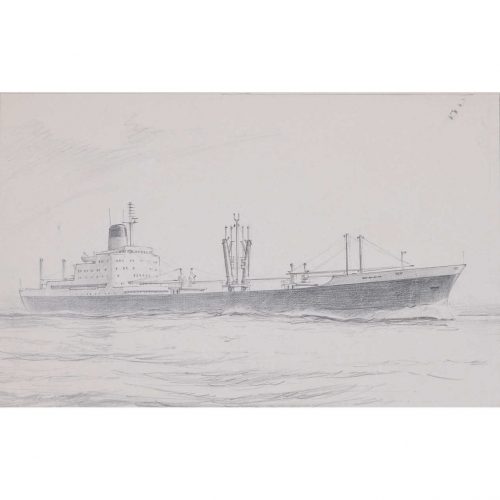
Laurence Dunn (1910-2006)
Coastal Ship
19.5 x 31.5 cm
Pencil on paperLaurence Dunn (1910-2006) was a well-known British marine artist and writer known for his depictions of ships. He grew up in Devon, where he practised drawing passing ships, and went on to study at the Central School of Art. He then worked for shipbuilding firm John I. Thornycroft & Company Limited, where he contributed to the design of the Royal Yacht. During the Second World War, Dunn worked in naval intelligence. In the early 1960s, he created many line drawings of Atlantic ocean liners.
Upon his death in 2006, the World Ship Society published the following obituary:
DUNN, Laurence. [December 15 2006 — Lloyds List] Many readers will be saddened by the death of well-known marine artist and writer Laurence Dunn in his 97th year. A man of encyclopaedic knowledge, he began his lifelong love of ships in Brixham, where he meticulously recorded passing traffic with the exquisitely accurate line drawings which later became something of a trademark. While studying at London’s Central School of Art his work was noticed by the Southern Railway, which commissioned profiles of its fleet, and this in turn led to work for Orient Line, where he also designed the well-known corn-coloured hull, and later Thorneycroft, where he helped with shaping draft plans for a new royal yacht. During the second world was he worked for naval intelligence at the Admiralty, where his technique did much to improve recognition standards, and greatly expanded his shipping clientele, becoming personally known to many chairmen. As well as the shipping press he worked for mainstream publications such as Everybody’s, Sphere and the upmarket comic Eagle. Through his many contacts he enjoyed going to sea in a great variety of ships from aircraft carriers to colliers. Laurence wrote several books, starting with ship recognition titles which introduced new standards of layout, but his best known work was probably Passenger Liners, which was widely taken up by the travel trade. His love of Greece, where he was an early publicist of island cruising, let to involvement in reshaping various passenger liners beginning with Greek Line’s OLYMPIA. In later life he designed several sets of shipping stamps for the Crown Agents, produced photographic volumes on Thames and Mediterranean shipping and still found time to enjoy the passing Thames traffic. Our sympathies go to his wife Jennifer, who provided succour to the many ship lovers who beat a path to the welcoming door of their Gravesend home.
-
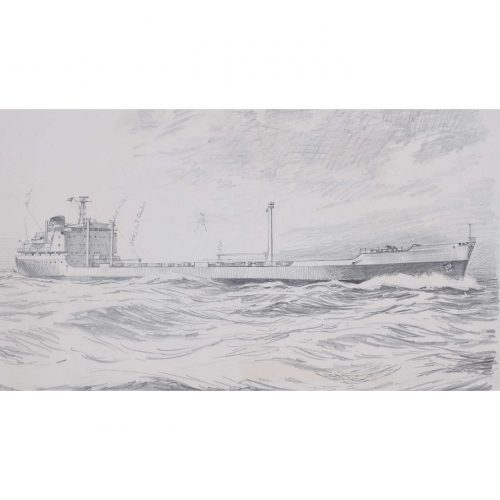
Laurence Dunn (1910-2006)
Coastal Tramp
25 x 38.5 cm Pencil on paperLaurence Dunn (1910-2006) was a well-known British marine artist and writer known for his depictions of ships. He grew up in Devon, where he practised drawing passing ships, and went on to study at the Central School of Art. He then worked for shipbuilding firm John I. Thornycroft & Company Limited, where he contributed to the design of the Royal Yacht. During the Second World War, Dunn worked in naval intelligence. In the early 1960s, he created many line drawings of Atlantic ocean liners.
Upon his death in 2006, the World Ship Society published the following obituary:
DUNN, Laurence. [December 15 2006 — Lloyds List] Many readers will be saddened by the death of well-known marine artist and writer Laurence Dunn in his 97th year. A man of encyclopaedic knowledge, he began his lifelong love of ships in Brixham, where he meticulously recorded passing traffic with the exquisitely accurate line drawings which later became something of a trademark. While studying at London’s Central School of Art his work was noticed by the Southern Railway, which commissioned profiles of its fleet, and this in turn led to work for Orient Line, where he also designed the well-known corn-coloured hull, and later Thorneycroft, where he helped with shaping draft plans for a new royal yacht. During the second world was he worked for naval intelligence at the Admiralty, where his technique did much to improve recognition standards, and greatly expanded his shipping clientele, becoming personally known to many chairmen. As well as the shipping press he worked for mainstream publications such as Everybody’s, Sphere and the upmarket comic Eagle. Through his many contacts he enjoyed going to sea in a great variety of ships from aircraft carriers to colliers. Laurence wrote several books, starting with ship recognition titles which introduced new standards of layout, but his best known work was probably Passenger Liners, which was widely taken up by the travel trade. His love of Greece, where he was an early publicist of island cruising, let to involvement in reshaping various passenger liners beginning with Greek Line’s OLYMPIA. In later life he designed several sets of shipping stamps for the Crown Agents, produced photographic volumes on Thames and Mediterranean shipping and still found time to enjoy the passing Thames traffic. Our sympathies go to his wife Jennifer, who provided succour to the many ship lovers who beat a path to the welcoming door of their Gravesend home.
-
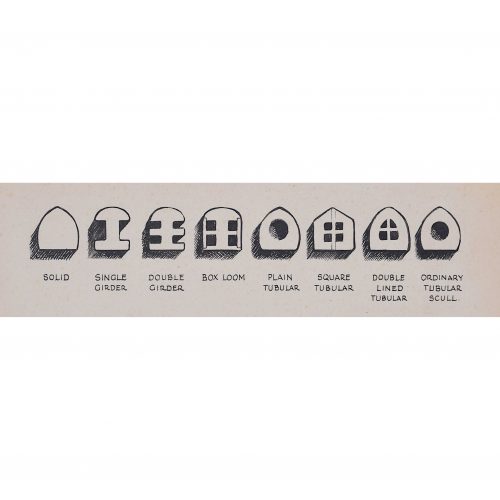
Laurence Dunn (1910-2006)
Fashions in Oars and Sculls
6 x 25 cm Ink on paperThis series of eight neat, ink illustrations depicts, as the title suggests, the various fashions of oars and sculls. These fashions include the Solid, Single Girder, Double Girder, Box Loom, Plain Tubular, Square Tubular, Double Lined Tubular and Ordinary Tubular Scull designs.
Laurence Dunn (1910-2006) was a well-known British marine artist and writer known for his depictions of ships. He grew up in Devon, where he practised drawing passing ships, and went on to study at the Central School of Art. He then worked for shipbuilding firm John I. Thornycroft & Company Limited, where he contributed to the design of the Royal Yacht. During the Second World War, Dunn worked in naval intelligence. In the early 1960s, he created many line drawings of Atlantic ocean liners.
Upon his death in 2006, the World Ship Society published the following obituary:
DUNN, Laurence. [December 15 2006 — Lloyds List] Many readers will be saddened by the death of well-known marine artist and writer Laurence Dunn in his 97th year. A man of encyclopaedic knowledge, he began his lifelong love of ships in Brixham, where he meticulously recorded passing traffic with the exquisitely accurate line drawings which later became something of a trademark. While studying at London’s Central School of Art his work was noticed by the Southern Railway, which commissioned profiles of its fleet, and this in turn led to work for Orient Line, where he also designed the well-known corn-coloured hull, and later Thorneycroft, where he helped with shaping draft plans for a new royal yacht. During the second world was he worked for naval intelligence at the Admiralty, where his technique did much to improve recognition standards, and greatly expanded his shipping clientele, becoming personally known to many chairmen. As well as the shipping press he worked for mainstream publications such as Everybody’s, Sphere and the upmarket comic Eagle. Through his many contacts he enjoyed going to sea in a great variety of ships from aircraft carriers to colliers. Laurence wrote several books, starting with ship recognition titles which introduced new standards of layout, but his best known work was probably Passenger Liners, which was widely taken up by the travel trade. His love of Greece, where he was an early publicist of island cruising, let to involvement in reshaping various passenger liners beginning with Greek Line’s OLYMPIA. In later life he designed several sets of shipping stamps for the Crown Agents, produced photographic volumes on Thames and Mediterranean shipping and still found time to enjoy the passing Thames traffic. Our sympathies go to his wife Jennifer, who provided succour to the many ship lovers who beat a path to the welcoming door of their Gravesend home.

